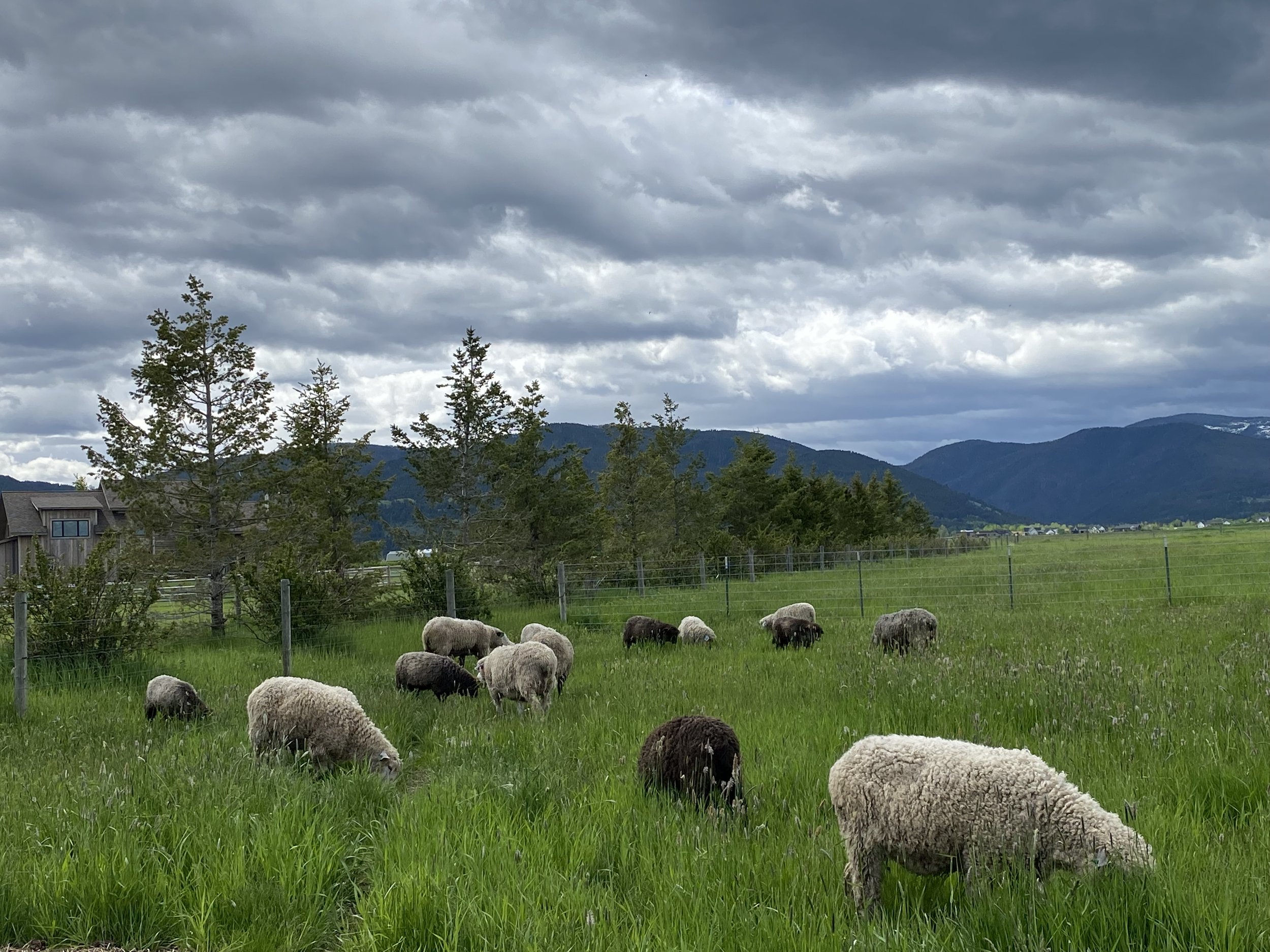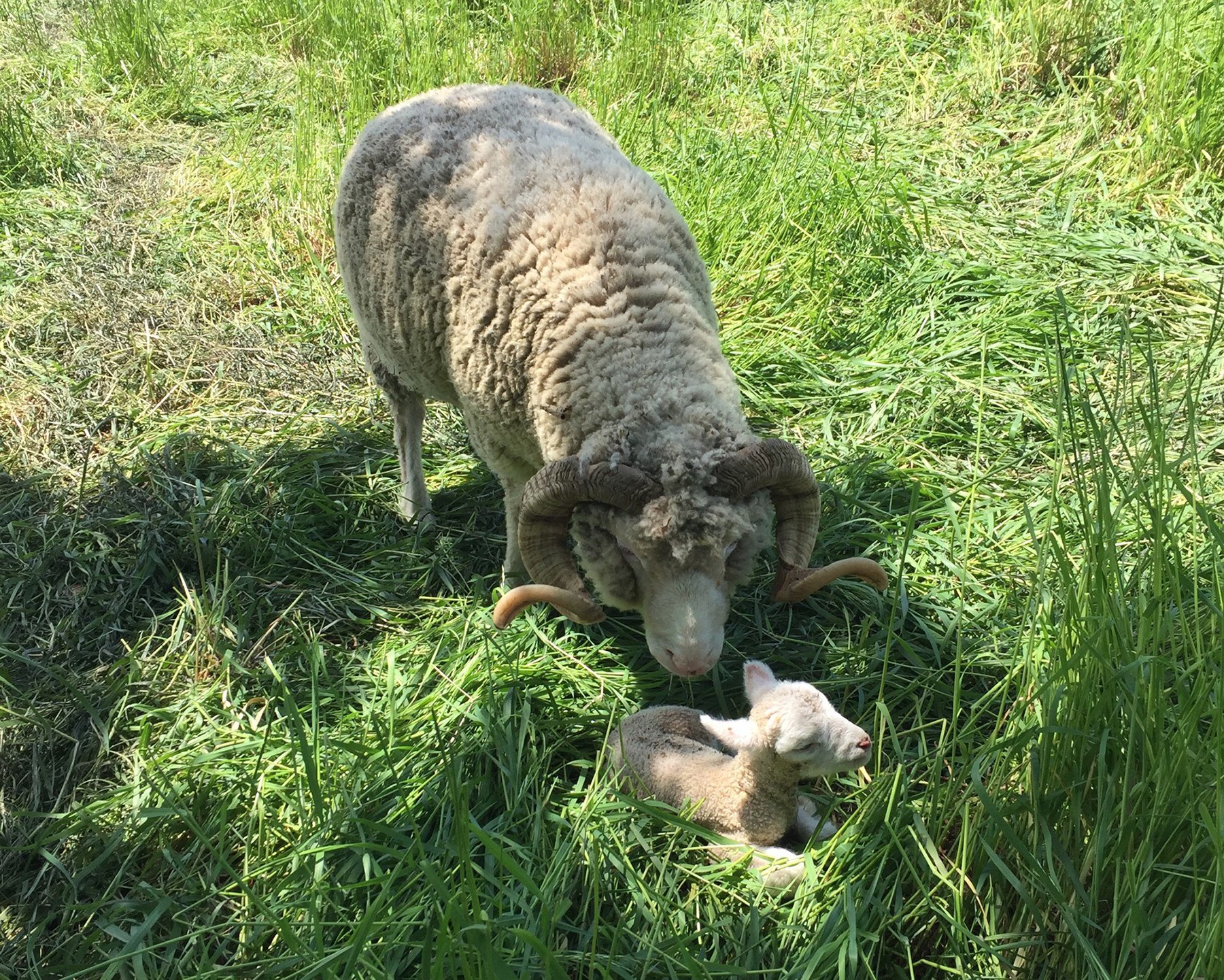
2023 Projects
Saving breeds on the ground from the verge of extinction.
2023 Sheep Project
Lincoln Longwool were established as an improved breed in 1796, with longwool sheep having been recordedback to the 1300's. Lincoln as their name suggests originated on the East Coast of England, bordering the NorthSea and county of Lincolnshire. At arguably the height of their popularity in the 1800's, the breed was imported to Canada.
Both sexes are naturally polled, the legs of Lincoln Longwools have a covering of wool as well, down to the feet.Lincoln are multi-purpose, heavily built, rugged, adaptable sheep with a calm and gentle disposition.
Lambs are small considering the size of the adult sheep. Ewes weigh around 80-120kg and rams, 120-160kg.
A Lincoln Longwool fleece can weigh from 6.8-11kgs and have a staple length of 18-20cms. Lincoln fleece is theheaviest, longest-stapled and most lustrous of any breed in the world which yields a very long, lustrous, coarse,strong, wave common or braid fleece. The fleece grows approximately 1" per month, locks are heavy, withdefined crimp and often spiraled tips in either white or naturally colored. The locks are extraordinarily lustrous and hence take color well when dyed. The natural-colored fleece includes white, silvery grays, black, charcoal,and red brown. Traditional use of the wool was for carpet & tapestry; luster, length, sturdiness and strength being the defining traits.
Currently there are 800 ewes left in their native UK, with most concentrated in Lincolnshire. In the event of adisease outbreak, it could prove to be devastating to the population as a whole. HLC has efforts underway to assist with the importation of new Lincoln genetics.
Lincoln Longwool
Leicester Longwool are among the rarest of the longwool breeds, with only 300 ewes left in their native UK and pockets of populations in othercountries. In a similar fashion to the Lincoln Longwool the height of their popularity during the Industrial Revolution was not matched in the long term, with the number of Leicester dwindling significantly from the 1930's onwards.
Although slower maturing than other breeds, Leicester Longwool are considered to be hardy (under the correct conditions), easy to work with,with a fleece which is highly regarded. Uses for their wool vary from tapestry to rug making, wall hanging and furnishings. In particular the lambswool makes excellent garments.
There has been active interest in recent years concerning the reintroduction of the Leicester Longwool to Canada, in order to help the global population. HLC holds semen in our inventory
We are looking for breeders who would be interested in partnering with HLC to accomplish this goal. Doing so is a long term investment, with the ability to promote, market and encourage the growth of the breed in Canada. Prior experience with sheep is an asset.
Leicester Longwool
Cotswold are descended from long wool sheep brought to the UK by the Romans. These sheep formed the basis of the Cotswold, Lincoln andLeicester breeds. Cotswold wool was so highly prized, their wool helped tobuild cathedrals and churches in England - inclusive of Gloucester Cathedral during the 15th century. Making Cotswold a part of the world'scultural heritage.
Cotswold were imported to Canada in the 19th century and were one of the most popular breeds of the time. During the 1920's, Merino became more favoured for wool and breeds such as the Suffolk and Dorset overtook Cotswold in terms of meat production. The overall population decreased in Canada and worldwide during a similar time period. Cotswold are designated as "endangered" in Canada and in the UK particular attention is being paid to their preservation, alongside other longwool breeds. There are currently only just over one thousand ewes left in Great Britain. In North America there were 130 registrations of Cotswold in 2022, when figures from the American Cotswold Records Association and CLRC arecombined
Breeders are collectively importing semen from the UK in 2023. In particular HLC is working to conserve a line of Cotswold, comprised of conservation genetics, which have been lost elsewhere in North America.
Cotswold
Dorset Horn first came to Canada in the 19th century. Up until the 1950's Dorset Horn remained popular. However, after the introduction ofthe Polled Dorset, numbers saw a steady decline. Today the breed is listed as "critical" with HLC.
Canada's Dorset Horn are close in type to the English Dorset Horn population. In other international populations there has been a move towards mixing polled Dorset into the gene pool. Making Canada's population special in ofitself.
Dorset Horn are able to breed "out of season". They are medium sized sheep. Their fleece is strong, extremely white and free of any othercolouring. Spinners find the wool particularly appealing to work with, it is suitable for clothing and can be readily used for knitting projects.
Another aspect of this versatile breed, is the quality of their milk. Dorset Horn can be milked, with the milk being used for cheese making.
HLC has been fortunate to with the Heritage Sheep Reproduction and select two traditional UK Dorset Horn rams for collection.
Dorset Horn
Border Leicester were first bred by Robert Bakewell of Dishley, Leicester,UK in the 1700's. Initially called Dishley Leicester, with varying crosses toother breeds, two distinct lines of Leicester were bred - farmers found astrong preference with one line and in 1850 the name Border Leicester was adopted.
The breed was first imported into Canada in the mid-1800's and hasmaintained a presence ever since. Although not as numerous in number, as their peak in popularity during the 1950's, Border Leicester are still valued for their traits. The ewes are particularly good mothers and their lambs show a good growth rate. As with heritage sheep breeds, Border Leicester do not need a diet which is heavy in proteins.
Their wool was used for carpets in the 1940's and 50's, but in recent years has found popularity among spinners, for the lustre and quality of the fibre.
HLC supports the efforts of breeders on the ground to select new bloodlines for the breed.
Border Leicester
With only 20 registered breeders of Shropshire left in Canada, HLc also undertook the decision to assist with the introduction of new genetics to the breed. UK Shropshire semen is available for import to Canada through Heritage Sheep Reproduction and OC Flock.
Shropshire
2023 UK Beef Semen Import
As a result of the importation by HLC of bovine semen from UK Sires, we have been able to introduce new genetics into the White Park herd in Canada. Currently there are less than 20 breeding females in total domestically. We have been selecting candidates for AI, both cows appear to have “settled” at this time and hope to complete embryo work in the future.
White Park are in need of those willing to work to conserve this breed into the future. Experience with cattle is a strong asset.
White Park
Milking Shorthorn Project
Milking Shorthorn Embryos
.Milking Shorthorn have a long history dating back to the 18thcentury in the UK, where in the Valley of the Tees River, astrain of dairy Shorthorn was developed. Up until the 1990'sMilking Shorthorn were known as Dual Purpose Shorthorn -the name change better suited their modern purpose.
Since the 1970's in an effort to widen genetic diversity withinthe Milking Shorthorn population and to keep up with modern demands in terms of dairy production, breeders haveincorporated outside genetics into the herd as a whole. The majority of Canadian Milking Shorthorn are 75% in purity orhigher - a number which is higher than the UK. There is sometimes confusion when conservation organizations listMilking Shorthorn as "critical" in status - registrations are higher - but the count is based on 100% pure Milking Shorthorn.
Milking Shorthorn have maintained characteristics which are true to the breed. Inclusive of efficient feed conversion,particularly strong feet and legs, high fertility rates, milkproduction averaging 9,000kgs. As well as being breed leaders in temperament and longevity.
Here at HLC we were thrilled to be given the opportunity by Lynmark Farms to work with some outstanding Canadian100% Milking Shorthorn genetics. Lynmark is home to strong family lines, with classification scores and milk records to match their pedigrees.
Sienna was selected for a flush, using sexed semen from the well known bull, Oxton Fever. The result was more than wehad expected! HLC now has eight 100% Milking Shorthorn,Grade 1 embryos from truly outstanding genetics.












